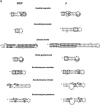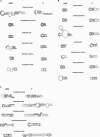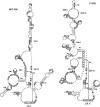Sequence analysis of RNase MRP RNA reveals its origination from eukaryotic RNase P RNA
- PMID: 16540690
- PMCID: PMC1440897
- DOI: 10.1261/rna.2284906
Sequence analysis of RNase MRP RNA reveals its origination from eukaryotic RNase P RNA
Abstract
RNase MRP is a eukaryote-specific endoribonuclease that generates RNA primers for mitochondrial DNA replication and processes precursor rRNA. RNase P is a ubiquitous endoribonuclease that cleaves precursor tRNA transcripts to produce their mature 5' termini. We found extensive sequence homology of catalytic domains and specificity domains between their RNA subunits in many organisms. In Candida glabrata, the internal loop of helix P3 is 100% conserved between MRP and P RNAs. The helix P8 of MRP RNA from microsporidia Encephalitozoon cuniculi is identical to that of P RNA. Sequence homology can be widely spread over the whole molecule of MRP RNA and P RNA, such as those from Dictyostelium discoideum. These conserved nucleotides between the MRP and P RNAs strongly support the hypothesis that the MRP RNA is derived from the P RNA molecule in early eukaryote evolution.
Figures





Similar articles
-
Secondary structure probing of the human RNase MRP RNA reveals the potential for MRP RNA subsets.Biochem Biophys Res Commun. 2005 Sep 23;335(2):314-21. doi: 10.1016/j.bbrc.2005.07.074. Biochem Biophys Res Commun. 2005. PMID: 16083861
-
Molecular modeling of the three-dimensional architecture of the RNA component of yeast RNase MRP.J Mol Biol. 1999 Oct 1;292(4):827-36. doi: 10.1006/jmbi.1999.3116. J Mol Biol. 1999. PMID: 10525408
-
Mutual interactions between subunits of the human RNase MRP ribonucleoprotein complex.Nucleic Acids Res. 2004 Apr 19;32(7):2138-46. doi: 10.1093/nar/gkh539. Print 2004. Nucleic Acids Res. 2004. PMID: 15096576 Free PMC article.
-
Architecture and function of the human endonucleases RNase P and RNase MRP.IUBMB Life. 2000 Apr;49(4):265-72. doi: 10.1080/15216540050033113. IUBMB Life. 2000. PMID: 10995027 Review.
-
Ribonucleases P/MRP and the expanding ribonucleoprotein world.IUBMB Life. 2012 Jun;64(6):521-8. doi: 10.1002/iub.1052. IUBMB Life. 2012. PMID: 22605678 Review.
Cited by
-
Inventory and analysis of the protein subunits of the ribonucleases P and MRP provides further evidence of homology between the yeast and human enzymes.Nucleic Acids Res. 2006;34(18):5145-56. doi: 10.1093/nar/gkl626. Epub 2006 Sep 22. Nucleic Acids Res. 2006. PMID: 16998185 Free PMC article.
-
RNase MRP and the RNA processing cascade in the eukaryotic ancestor.BMC Evol Biol. 2007 Feb 8;7 Suppl 1(Suppl 1):S13. doi: 10.1186/1471-2148-7-S1-S13. BMC Evol Biol. 2007. PMID: 17288571 Free PMC article.
-
The L7Ae protein binds to two kink-turns in the Pyrococcus furiosus RNase P RNA.Nucleic Acids Res. 2014 Dec 1;42(21):13328-38. doi: 10.1093/nar/gku994. Epub 2014 Oct 31. Nucleic Acids Res. 2014. PMID: 25361963 Free PMC article.
-
Targeted CRISPR disruption reveals a role for RNase MRP RNA in human preribosomal RNA processing.Genes Dev. 2017 Jan 1;31(1):59-71. doi: 10.1101/gad.286963.116. Epub 2017 Jan 23. Genes Dev. 2017. PMID: 28115465 Free PMC article.
-
Transcriptional control of an essential ribozyme in Drosophila reveals an ancient evolutionary divide in animals.PLoS Genet. 2015 Jan 8;11(1):e1004893. doi: 10.1371/journal.pgen.1004893. eCollection 2015 Jan. PLoS Genet. 2015. PMID: 25569672 Free PMC article.
References
-
- Altman S. Nobel lecture. Enzymatic cleavage of RNA by RNA. Biosci. Rep. 1990;10:317–337. - PubMed
-
- Altman S., Kirsebom L. Ribonuclease P. In: Gesteland R., et al., editors. The RNA world. Cold Spring Harbor Laboratory Press; Cold Spring Harbor, NY: 1999. pp. 351–380.
-
- Baldauf S.L., Roger A.J., Wenk-Siefert I., Doolittle W.F. A kingdom-level phylogeny of eukaryotes based on combined protein data. Science. 2000;290:972–977. - PubMed
-
- Chang D.D., Clayton D.A. Mouse RNAase MRP RNA is encoded by a nuclear gene and contains a decamer sequence complementary to a conserved region of mitochondrial RNA substrate. Cell. 1989;56:131–139. - PubMed
Publication types
MeSH terms
Substances
LinkOut - more resources
Full Text Sources
